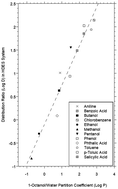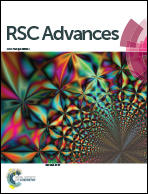Systematic evaluation of hydrophobic deep-melting eutectics as alternative solvents for the extraction of organic solutes from aqueous solution
Abstract
The partitioning of a number of organic compounds, including a series of n-alkanols and various simple, substituted benzene derivatives, between several hydrophobic (i.e., water-immiscible) deep eutectic solvents (HDESs) and water has been examined. The extent of extraction is shown to vary with the charge state of the molecule and the composition of the eutectic. In addition, the HDES–water distribution of a given solute is found to be directly proportional to (but typically less than) its partitioning in the octanol–water system, consistent with a significant role for solute hydrophobicity in the observed extraction behavior. Comparison of solute extraction into an HDES to that observed for other “unconventional” solvents (e.g., room-temperature ionic liquids and a soybean-derived oil) shows that hydrophobic deep eutectic solvents provide comparable or superior extraction efficiency.



 Please wait while we load your content...
Please wait while we load your content...